Colour circle diagram for paint mixing exercise

Instructions
On the outer ring (showing saturated or vivid hues), put the two versions of each primary colour ('Permanent Rose', 'Cadmium Red',
'Cadmium Yellow Deep', 'Cadmium Yellow Deep', ' Cadmium Yellow Pale', 'Cerulean Blue' and 'Ultramarine Blue' into the appropriate segments
(appropriate alternative colours may be substituted if necessary, for example you might use 'Vermilion' in place of 'Cadmium Red'). Create the
secondary colours on the outer ring by mixing from the adjacent primaries, varying the quantity of each primary as appropriate (for example create
'Yellowish Green Mix' from Cadmium Yellow Pale and Cerulean Blue with more yellow and a very small amount of blue; but create 'Blueish Green Mix'
from the same primary colours but with more blue and less yellow.
The inner ring (showing less saturated or dull colours), consists of the same colours as on the outer ring but dulled down or darkened by either
adding a small amount of the opposite or complimentary colour (for example dull down Cadmium Red with a small amount of your Blueish Green Mix; or
simply add small amounts of the ingredients of this mix - Cadmium Yellow Pale and Cerulean Blue), or by adding a small amount of black (in the case
of yellows also add a small amount of Permanent Rose otherwise black will make a yellow appear green, and in the case of Permanent Rose also add a
small amount of Cadmium Yellow Pale otherwise black will make Permanent Rose appear violet).
In the centre you can create a colour similar to black from one of each of the primaries (use 'Cadmium Red', 'Cadmium Yellow Pale' and 'Ultramarine'),
or simply use black (e.g. Mars Black).
Colour circle diagram of tints for paint mixing exercise

Instructions
On the outer ring repeat the same colours used on the outer ring of the first colour circle, but lightened to produce tints of those colours.
If working with acrylic, oil or gouache paints this should be done by adding white (e.g. 'Titanium White'). If working with water colours you
should thin down the colour with water to produce a tint. Note that in order to show a difference between this colour circle and the first one
it is recommended that you make these tints reasonably pale. It may be a good idea to create these tints at the same time as creating your initial
mixes for the secondary colours to save having to mix them again.
The inner ring will show duller versions of these tints, made by either adding a small amount of the complementary colour, or by adding a small
amount of black as on the previous colour circle. These colours will appear as grey versions of each tint.
In the centre create a grey by either mixing together three primaries (use 'Cadmium Red', 'Cadmium Yellow Pale' and 'Ultramarine') plus white,
or by mixing black with white (for water colours substitute more water for the white).
Click here for notes on colour mixing to explain this exercise




